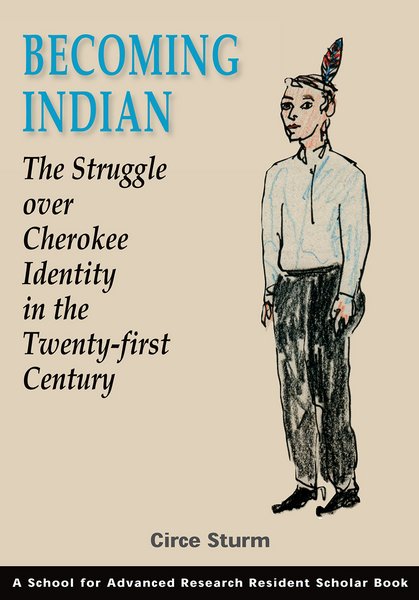Becoming Indian: The Struggle over Cherokee Identity in the Twenty-First Century by Circe Sturm (review) [Steineker]Posted in Articles, Book/Video Reviews, History, Media Archive, Native Americans/First Nation, United States on 2014-08-22 13:40Z by Steven |
The American Indian Quarterly
Volume 38, Number 3, Summer 2014
pages 400-402
DOI: 10.1353/aiq.2014.0028
Rowan Faye Steineker
Department of History
University of Oklahoma
In Becoming Indian, anthropologist Circe Sturm provides another innovative study of Cherokee identity politics to accompany her previous work, Blood Politics. Sturm uses ethnographic data to explain the contemporary phenomenon of “racial shifting,” which she defines as the process of reallocating one’s racial self-identification from non-Indian to Indian. This surprising and controversial demographic trend has caused the number of people claiming a Native identity on the US Census to increase over 300 percent between 1960 and 2000. Additionally, the number of people claiming to be of mixed Native American descent grew by over 600 percent during the same period. Most of these racial shifters have gravitated toward a Cherokee identity, a trend that Sturm attributes to a history of cultural syncretism, high rates of exogamy, and Cherokee tribal enrollment policies, leading to the public perception that most Cherokees appear white. As a result, the number of self-identified Cherokee individuals in the United States has grown at an astonishing rate during the past thirty years. In order to shape this provocative study, Sturm conducted ethnographic fieldwork as well as documentary research among multiple self-identified Cherokee organizations, including the three federally recognized Cherokee groups: the Cherokee Nation, the Keetoowah Band of Cherokee Indians, and the Eastern Band of Cherokee Indians. She also skillfully builds upon historical studies concerning race, whiteness, and Native identity within American society, including Phil Deloria’s Playing Indian and David Roediger’s Wages of Whiteness.
Sturm divides the study into two sections: “Racial Shifters” and “Citizen Cherokees.” In the first, she provides a detailed examination of racial shifters and their motivations for reindiginization based on her research among members of self-identified Cherokee organizations. She found that they claimed a Native identity based on a variety of reasoning, including newly discovered and documented Native ancestry, undocumented family stories, or even spiritual feelings. Despite their differences, Sturm finds that typical racial shifters previously identified as white, yet they all assert claims to indigeneity using blood discourse. After analyzing the narrative accounts used by racial shifters, she concludes that conceptions of whiteness drive this identity transformation. Racial shifters describe their change to Cherokeeness using a discourse of whiteness, an identity that they associate with the “excesses of American individualism, secularism, and anomie” (85). Sturm argues that these racial shifters undergo a type of conversion involving a search for a meaningful life, social transcendence, a process of socialization, and proselytization similar to a religious conversion experience. This process of converting to Cherokee neotribalism allows racial shifters a means to repudiate their whiteness and find a “remedy for the ‘ills of the modern, neoliberal age’ while keeping their white privilege” (85). Thus, Sturm greatly complicates widely held notions concerning racial shifters, particularly the argument that most are motivated by material gain. She also places the discussion of Native identity within a very present context that demonstrates shifting conceptions of race, indigeneity, and American identity within the cultural and political climate of the late twentieth and early twenty-first centuries.
While Sturm provides a balanced portrayal of racial shifters in an attempt to explain the cultural reasoning underlying their transformation, she clearly demonstrates that racial shifting is also a political act with numerous consequences. She does so by devoting the second half of the study to the reaction of members of the three federally recognized Cherokee groups to individuals and groups claiming Cherokee identity. Through their reactions, she explores how racial shifting is profoundly affecting what it means to be a member of a sovereign Native nation. Typically, these “citizen Cherokees” react negatively toward people trying to reclaim an indigenous status. As Native Americans via documented ancestry and political recognition, “citizen Cherokees” often use terms such as “wannabes” and “fake Indians” to describe racial shifters whom they commonly view as “poor white trash” attempting to access a higher social status. Sturm also describes several cases of racial shifters misappropriating Native symbols and beliefs in ways that are offensive toward “Cherokee citizens.” Not only is racial shifting a cultural threat to “Cherokee citizens,” it also becomes a legal threat to their political status as federally recognized members of sovereign indigenous nations, especially as some states have begun to legally…

